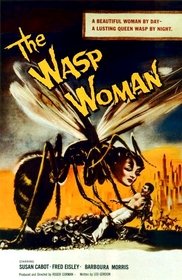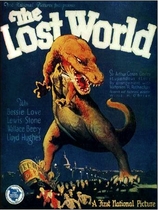Our editor-in-chief Nate Yapp is proud to have contributed to the new book Hidden Horror: A Celebration of 101 Underrated and Overlooked Fright Flicks, edited by Aaron Christensen. Another contributors include Anthony Timpone, B.J. Colangelo, Dave Alexander, Classic-Horror.com's own Robert C. Ring and John W. Bowen. Pick up a copy today from Amazon.com!
The Wasp Woman (1960)
Ahhh… the world would be so boring without Roger Corman directing movies like The Wasp Woman.
This Corman classic was shot in Los Angeles, and like many of his B-gems, required a miniscule budget of less than $50K and was completed in less than a week. Known also as The Bee Girl and Insect Woman, and borrowing thematically from the popular 1958 cult classic The Fly, the surrealistic The Wasp Woman features Susan Cabot as Janice Starlin, a Madison Avenue CEO leading a cosmetics company suffering from diminishing sales. Starlin and her wrinkles are blamed for the company’s problems, so she procures the assistance of eccentric researcher Eric Zinthrop, who discovers that wasps’ enzymes can reverse the aging process. Seduced by the opportunities his elixir presents, Starlin becomes Zinthrop’s guinea pig. Her employees quickly determine that something strange is brewing in the company’s research labs, and when they investigate, Starlin wreaks havoc after transforming into a wasp.
Cabot is sexy and effective as the determined Starlin. Her sleek dresses and black hair foreshadow the nimbleness she employs to become an evil Queen Wasp. Starlin commands everyone’s attention, viewers and corporate puppets alike, because of her looks and the power she wields as a corporate executive.
And execute she does with passion! From a corporate and feminist perspective, she is seductive as she cautiously embraces Zinthrop’s zany idea. As a CEO, her no-nonsense demeanor, both before and after her metamorphosis, blends nicely with her monstrous dark side, and her gruff exterior frequently stings her minions. Although her transformation may have produced increased revenue for the company, it costs her and her colleagues their lives. Simplistically, The Wasp Woman is a morality tale revealing the dangers of going too far for corporate profits.
Many critics consider The Wasp Woman the first feminist horror film, and although that claim is debatable, it buzzes with feminist interpretations because of Cabot’s performance. That a woman is leading a major corporation is provocative, but that she uses men as means to her end, and kills a few in the process, was cutting edge for 1960. However, the film does connote patriarchal themes: the company’s downfall is blamed on her physical appearance, and the film implies that Corporate America struggles when women navigate the ship. By placing the alluring “fountain of youth as magic potion” theme in perfume bottles, the film suggests that only women pursue youthful looks, an idea that recalls this contradiction: when men age, they grow wiser, but when women age, they grow less attractive. Starlin too easily accepts blame, but at least she aggressively seeks a solution, albeit a wacky, murderous one.
The wasp woman herself is bizarre, gashing her victims with slashes then sucking blood from their necks like a vampire. With fangs, a furry face, and a bloody appetite, one wonders if entomologists were on the set. The film’s poster contradicts the film’s featured creature: it has the head and “hands” of a wasp, not a woman as the poster illustrates. The movie also boasts a buggy green sepia tone, which reminds one of nature’s hues and critters such as katydids, praying mantises, or inchworms.
Corman plays with the Zinthrop character and its mad scientist implications, but the old researcher is not mad; he is just too scientifically curious. He seems more like a blue-collar absent-minded professor seeking a paycheck than a Dr. Frankenstein, and since a woman and money direct Zinthrop’s actions, he is more sympathetic and vulnerable than previous doctors mad in their pursuit for knowledge. Partly what makes The Wasp Woman work is that Zinthrop and Starlin are believable: their collaboration and its toxic results seem more a genuine mistake than an evil conspiracy.
Since the film surfaced during the remaining vapors of the post-World War II counterculture spirit, it foreshadows the drug culture that infiltrated 1960s America. The idea that a quick fix could reverse a social paradox such as natural aging and lead to personal and collective happiness ran rampant a few years later, with the hippy generation experimenting with chemicals and drugs to promote peace. The “live now, pay later” mentality inherent in Zinthrop’s experiment is also reminiscent of this culture. That a corporate leader could succumb to this mirage reveals how persuasive the drug culture was becoming among not only baby-boomers, but also their elders.
The film is filled with flaws, as are so many of Corman’s flicks, but who cares? Why would a bee handler not use gloves? Do wasps suck blood? How could a corporation get away with such cavalier use of bug juice (shouldn’t a government agency such as the FDA stepped in?)? None are fatal, and with Corman, mistakes are part of the aesthetic that complements his theory of “guerilla cinema”: take chances, have fun, and let viewers decide.
The character Bill Lane says, “there's something about this whole business that doesn't smell right,” a clause that may allegorically reflect the film industry as well, which at the time Corman and his independent-minded peers were subverting. That’s right Bill, with Roger Corman, stench never smelled so good.
This review is part of Roger Corman Week, the first of four celebrations of master horror directors done for our Shocktober 2007 event.








